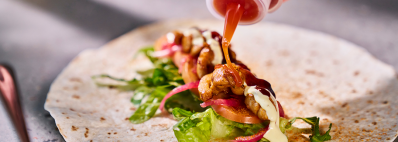Promotional Features
Unlocking pathways to healthier snacks
Health and taste in one bite
Consumers are demanding more and more from their snacks. Today, healthier, better-for-you snacks are an emerging market as consumers seek out products that deliver an improved sense of general wellbeing. In this environment, significant opportunities await manufacturers that meet the health and wellness priorities of consumers without compromising on taste and texture. The pressures play to the culinary, functional and nutritional capabilities of Solina.
Snack manufacturers can no longer focus on sensory attributes at the expense of other properties. A Global Data survey found 82% of Europeans are concerned about their physical fitness and health. An earlier version of the survey found consumers are focused on reducing their intake of sugar, fat and salt—the ingredients that are critical to the sensory desirability and moreishness of snacks.1
The near-universal concern about physical fitness and health reflects the long-term shift to healthier lifestyles and the impact of the pandemic, which accelerated the trend by re-emphasising the effect of diet on wellbeing. Consumption of crisps increased during the pandemic but people sought to stay healthy while snacking more by seeking out better-for-you products.2 Increasingly, snacks that deliver a beneficial purpose are replacing mindless munching.
Authorities are supporting the rise of healthier snacking through initiatives such as Nutri-Score, which enables consumers to quickly see the nutritional properties of products. Market research shows that the front of pack information boosts demand for healthier snacking and has a strong impact on the choices of consumers. Equally, some authorities are restricting advertising of products that are high in fat, sugar or salt (HFSS).3,4 Research suggests reformulating HFSS products to reduce fat, sugar or salt is the best way to mitigate actions against HFSS snacks.5
Reformulation and the development of new, better-for-you snacks can enable manufacturers to align their products with consumer demands for foods that use natural ingredients and deliver functional benefits while being low in fat, sugar and salt. The challenge is to reduce fat, sugar and salt without compromising on taste and texture.
Managing diverse demands on snacks
A new level of expertise is required to formulate snack seasonings that offer both the taste and the technical, functional and nutritional benefits desired by consumers and manufacturers. Taste remains the key driver, with surveys showing consumers want functional and nutritional benefits as well as, not instead of, sensory properties.6 To further complicate matters, consumers also want snacks to be cleaner and more sustainable, with people prioritizing products made from local, organic ingredients.
Manufacturers need to address those diverse demands without affecting technical aspects. Powder handling and flowability are critical, to limit production line waste, and cannot be compromised when changing the nutritional properties of a product. The situation necessitates an approach based on advanced expertise in nutrition and ingredients.
Solina is helping manufacturers rise to the challenge with a four-pillar approach to snacks designed to address new market requirements and serve the industry. The pillars are: a chef approach for unique flavours; a technical approach with experts in rheology for processability and minimum waste; a local approach to markets for taste preferences and agility in sourcing; and a nutritional approach informed by knowledge of ingredients, including a permanent survey of novel ingredients with nutritional or functional properties.
Those pillars support work to develop seasonings and coatings that leverage the healthy attributes of the snack with lower levels of fat, salt and sugar, offer more transparency, contain clean and trustable ingredients, and enhance nutritional benefits using proteins, fibres and more. Through those actions, seasonings and coatings can help snacks comply with non-HFSS regulations or bring the Nutri-Score up to A or B.
The work builds on Solina’s history in healthy seasonings and the nutritional expertise of Laboratoire PYC, the company’s nutritional subsidiary. Supported by such expertise, manufacturers can achieve clean labels, for example by removing additives, and add fibres and proteins, enriching their snacks with specially selected ingredients and flours from pulses, lentils, fava beans, peas and more.
When paired with solutions to reduce the fat content and the oil spray dosage and natural reduced sea salt solutions, the actions can enable snack manufacturers to claim “sources of fibres,” make Nutri-Score A or B claims, or comply with new HFSS regulations and guidelines.
Connecting Healthy to Foodie with taste
The final, crucial step of the formulation process is to design a custom-made seasoning that offers the full-taste impact together with nutritional benefits to ensure consumer satisfaction. Taste is 80% of the value of the product. As such, when improving the nutritional profile it is key to ensure that no compromise is made on taste.
That is a challenge because reducing fat and salt directly impacts aromatic perception and disturbs the overall aromatic profile of the snack. Fat reduction leads to the loss of the fatty mouthfeel that is central to the appeal of many snacks. Reducing sodium levels degrades the aromatic impact and the long-lasting perception.
An approach that combines expertise in taste and nutrition is needed to maintain healthy attributes and restore and provide flavour impact, salt perception, fatty mouthfeel and flavour release. Solina brings its culinary heritage and its specific “chef-approach” to the challenge, enabling it to find the flavour profile in connection to the substrate and ultimately to balance nutrition and taste.
The effectiveness of the approach is illustrated by Solina’s work on a mass-market corn snack. Solina made three key changes to improve the Nutri-Score from C to B. Firstly, the team selected rice and fava bean flours for the formulation because of their excellent flowability, adhesion and dispersion of the seasoning on the substrate. The flours enabled Solina to keep the oil sprayed dosage at 8%.
Secondly, the team used low-salt solutions based on natural, sodium-reduced sea salt. Switching to the sea salt enabled Solina to control the sodium content and thereby have a positive impact on the final calculation of the Nutri-Score of the product.
Finally, the team enriched the seasoning dusts with fibres. The enrichment helped to clear the bar for Nutri-Score B and, as the fibre content of the finished product exceeded 3%, enabled the brand to make the health benefit claim “source of fibres” on the pack.
Delivering the full package of snack expertise
Solina’s chefs, flavourists and ingredient experts are supported by marketing and R&D teams that check the global food scene for emerging trends, new cuisines and ingredients, and trendy combinations of ingredients and spices in search of the next hot flavour.
Collectively, the teams deliver healthy, tasty and nutritious snacks that meet demands for non-HFSS, “Low & No”, and Nutri-Score A or B products. Brands that partner with Solina receive innovative and clean recipes with flowability performance, enabling them to turn greasy favourites into healthy, permissible, non-guilty, low-calorie alternatives without compromising the full taste impact of the snacks.
References
1. Brands should develop guilt-free indulgences as consumers become more cautious of ingredients - GlobalData. https://www.globaldata.com/brands-develop-guilt-free-indulgences-consumers-become-cautious-ingredients/ (2021).
2. Study: COVID-19 impact on consumer food behaviours in Europe. https://eit.europa.eu/library/study-covid-19-impact-consumer-food-behaviours-europe (2021).
3. Restricting promotions of products high in fat, sugar and salt by location and by price: enforcement. https://www.gov.uk/government/consultations/restricting-promotions-of-products-high-in-fat-sugar-and-salt-enforcement/restricting-promotions-of-products-high-in-fat-sugar-and-salt-by-location-and-by-price-enforcement.
4. Egnell, M. et al. The impact of the Nutri-Score front-of-pack nutrition label on purchasing intentions of unprocessed and processed foods: post-hoc analyses from three randomized controlled trials. Int. J. Behav. Nutr. Phys. Act. 18, 38 (2021).
5. Morrison, O. How UK brands are reformulating to avoid the HFSS ad ban. https://www.foodnavigator.com/Article/2021/05/19/How-UK-brands-are-reformulating-to-avoid-the-HFSS-ad-ban (2021).
6. Welshans, K. Taste, price still dominate food purchasing factors. https://www.feedstuffs.com/news/taste-price-still-dominate-food-purchasing-factors (2020).







